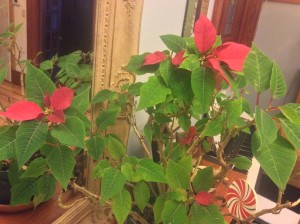
The supermarkets in the UK currently have shelves full of Poinsettia (Euphorbia pulcherrima) with the distinctive bright red bracts, but poinsettia production is a risky business with high fuel costs and low retail prices causing some UK growers to reduce production. However there is no suggestion yet that poinsettias will be replaced with hardier plants such as hybrid Cyclamen even though these can provide a very long season of bright red flowers. One of the problems is that homes are generally heated to temperatures that suit poinsettia better than Cyclamen so the needs of the homeowner and the producer may not match up. Today’s blog is kindly provided by Dawn Bazely who has experience of poinsettia as both a house plant and a garden plant.
Alastair Culham
By Dawn Bazely

Poinsettias are native to Mexico and Central America, where they have been associated with Christmas since European missionaries colonized the americas in the 17th century. They are the top-selling potted plant Canada and USA. What most people think of as the red flower petals, are actually bracts, which are modified leaves. The actual flower is very small.

The plant’s common name has its roots in the surname of Joel Roberts Poinsett, the first United States Minister to Mexico. In 1828 he observed the plant and sent it home to the USA where it can grow outside in the south. When growing in the wild (or in gardens) in Mexico, like here, the plant is a tall, leggy bush.
In the early 1900s, a German immigrant to California, Paul Ecke, sold cut stems of poinsettia at his farm stand, but he later developed a grafting technique that produced the compact, dense potted plants with multiple flower stems per plant, that we see today. His son and grandson marketed poinsettias intensively, which is why they are so ubiquitous. There are dozens of varieties today, ranging from red, to pink, to white.
Schools often do fund-raising by selling poinsettias to hapless parents and neighbours (like me). I’ve managed to keep my various poinsettia plants alive from one year to the next. Here’s a 3-year old straggly plant that has flowered again!

References
http://www.poinsettiaday.com/index.html
http://urbanext.illinois.edu/poinsettia/facts.cfm
The RHS provide practical advice on what to do with your poinsettia to ensure a neat well coloured plant for next year.
Editor’s note
In 2002, December 12th became National Poinsettia day in the USA in celebration of the work of Paul Ecke Jr. in commercialising this species (Poinsettia Day). The date commemorates the death of Joel Roberts Poinsett, the discoverer of the species.
